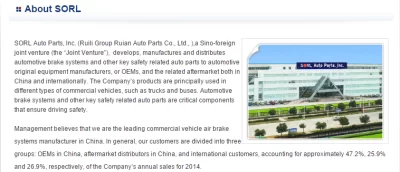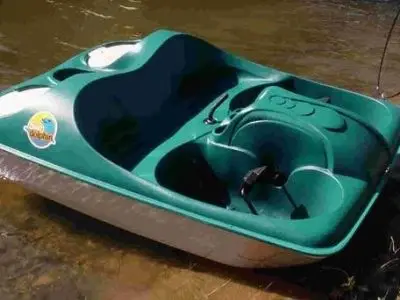 The first place I start when attempting to analyze a company is to head over to yahoo.finance.com and look the ticker (SORL) up. Based on the P/E (3.65) something must be terribly wrong with this company. Our purpose here is to figure out what the problem is. My first guess is to assume that the earnings over the past year have some kind of adjustment which causes them to be overstated for some reason. To check for this we’ll go to the income statement page on yahoo finance. SORL’s net income over the last three years hasn’t varied too much. The low is about $9 million and the high is about $13 million. The most recent annual data is 2014. Maybe the last couple of quarters have been really bad. We can adjust the view on the income statement to “quarterly”. It appears that the last two quarters together brought in $5.25 million, not on track for the best year but not terrible either.
The first place I start when attempting to analyze a company is to head over to yahoo.finance.com and look the ticker (SORL) up. Based on the P/E (3.65) something must be terribly wrong with this company. Our purpose here is to figure out what the problem is. My first guess is to assume that the earnings over the past year have some kind of adjustment which causes them to be overstated for some reason. To check for this we’ll go to the income statement page on yahoo finance. SORL’s net income over the last three years hasn’t varied too much. The low is about $9 million and the high is about $13 million. The most recent annual data is 2014. Maybe the last couple of quarters have been really bad. We can adjust the view on the income statement to “quarterly”. It appears that the last two quarters together brought in $5.25 million, not on track for the best year but not terrible either.
Cash Flow
Next thing to check up on is the cash flows. Perhaps the company is making large accounting profits (net income) but is actually hemorrhaging cash. By looking at the “cash flow” page a very different picture develops. Total cash flow from operating activities is what we are looking at here. From this we are going to subtract capital expenditures to get an idea of the cash that comes into the company, which owners might be able to keep. Operating cash flow is all over the map. The lowest in the last three years is $1 million, and the highest is $31 million.
Capital Expenditures
Capital expenditures seem to be substantially smaller than depreciation. This could be a warning sign that the business is slowing down. Depreciation should similar to capital expenditures on average. When a company makes a capital expenditure, say they buy a piece of equipment, like a truck. Every year they charge a percentage of its value as depreciation against income. The percentage is based on how long they expect the truck to last, so if they expect it to last 10 years they charge 10% of its value as depreciation. When they buy the truck the whole thing is charged at once against cash flow as a capital expenditure. Therefore, over the course of ten years, if they just buy one truck, the total charged against cash flow as a capital expenditure and the total charged against income as depreciation should be the same. If capital expenditures are chronically lower than depreciation that could mean that the company isn’t replacing its equipment as fast as the equipment is getting used up. We should take this into account. If SORL was spending $7 million (roughly its depreciation) every year in capital expenditures it would have been cash flow negative (meaning cash was going out the door rather than in) during 2013.
Other items on the cash flow page
You may also notice there are some other items that bring up questions. What did SORL just spend $34 million dollars investing in? Why is the company taking on so many liabilities? To answer these questions we go to the “balance sheet” page! The first thing that I always like to check is the difference between current assets (stuff that the company expects to get cash for within the year) and total liabilities (also known as the net current asset value or NCAV). The larger that number is compared to the market capitalization (total number of shares multiplied by the share price) the safer the company is. By switching to quarterly data we see the balances as of the most recent quarter. This is starting to get quite suspicious. The net current asset value of this company is $169 million, that works out to $8.75 per share, the share price is $2.20. If the company simply liquidated shareholders could end up with a 300% gain! Numbers like this good are extremely suspicious and generally mean that we’re missing something important!
It’s a Chinese company
The business description has an important note:
SORL Auto Parts, Inc. develops, manufactures, and distributes automotive brake systems and other safety related auto parts. It operates in two segments, Commercial Vehicle Brake Systems and Passenger Vehicle Brake Systems. The company produces a range of products covering 65 categories and approximately 2000 specifications in automotive brake systems and others safety related auto parts. Its products are principally used in various types of commercial vehicles, such as trucks and buses. SORL Auto Parts, Inc. markets its products under the SORL brand to automotive original equipment manufacturers and the related aftermarket. The company sells its products in approximately 104 countries and regions. SORL Auto Parts, Inc. was founded in 2003 and is based in Rui’an, the Peoples Republic of China.
Emphasis mine. Over the last several years it was discovered that several companies in China were fraudulently overstating their accounts. This is a possible explanation for this company’s valuation as well. If it isn’t a fraud the company is probably worth $10 per share, or at least $4 per share. If the company is a fraud it’s probably worth $0. This is good news, because we know one thing for sure, there’s no way SORL is worth $2.20 a share. Its either worth a lot more or a lot less. If its a fraud we can short it and make money, if its the real deal we can buy it and make money, so what now? The important question now is how do we determine if SORL really has the goods or not, or at least what is the probability that the accounting statements are truthful? Well, it looks like its time to go to www.SEC.gov and start pulling some financials!
Disclaimer: I have no position in SORL, I reserve the right to either buy or short it at some point over the next week, if I do I will update this disclaimer. Nothing I’ve written here is investment advice, but is rather my opinion. Do your own research before buying, selling, or holding any stock, bond, or other financial instrument.
Adam Woods is a physicist. His research interests include building software to run and build geomagnetic models. Adam got interested in personal finance in the great recession when it became obvious an interest was necessary.
After harassing his friends and family (and a short intervention) he took to the web where he blogs about finance, investment, politics, and economics.
Adam is currently located in Boulder, Colorado where he can generally be found hiking, biking, or running a D&D campaign. He can also be contacted at adamwoods137@gmail.com.






